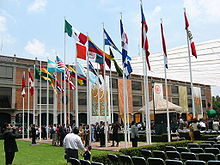Cholula, Puebla
The city is unified by a complicated system of shared religious responsibilities, called cargas, which function mostly to support a very busy calendar of saints' days and other festivals which occur in one part or another almost all year round.
[3] This museum was opened in September 2001, after a renovation project beginning in 1997 restored interior and exterior features such as stone sculptures as well as the original floor plan.
[3][11] Because of the student population associated with the Universidad de las Américas, and the area's popularity with tourists, the city has a lively nightclub and bar scene, mostly concentrated around the main plaza and in a part of the San Andrés municipality.
The decoration is based on paintings by Federico Silva and Gerardo Gomez Brito, various pieces done in local onyx and a number of antiques from various places in the world.
Fifty of these containers have been joined and painted with bright colors to create 4,500 metres (14,800 ft) of spaces used to house workshops, restaurants, galleries and other businesses.
[13] Parque Loro is a petting zoo containing more than 400 animals, including endangered species like monkeys, tigers, jaguars, pumas, reptiles and miniature horses.
[15] On Wednesdays and Sundays, this market is augmented by street vendors, which is called a tianguis, because on these days, people from the communities surrounding the city come to buy and sell.
[4] However, the walls of the large inner courtyard have mosaics of encrusted volcanic stone that depict a goat, a rabbit, flames and elements of the Passion of Christ, such as the weeping face of Saint Veronica, her tears flowing red.
The second hall features finds from the area including clay figures, pots, other containers, and items of stone and shell, along with recreations of the two main murals of the pyramid complex.
The Quetzalcoatl ritual is performed on the pyramid on both the spring and fall equinoxes, with poetry, indigenous dance, music played on pre-Hispanic instruments and fireworks.
[16] The atrium is small, but its position at the top of the pyramid affords views of the Popocatepetl and Iztaccíhuatl volcanoes, the flat valley floor and the large number of church cupolas that dot the city.
The cupola contains allegorical paintings and on the pendentives, there are the four doctors of the Catholic Church, Francis de Geronimo, Pope Gregory I, Ambrose and Augustine of Hippo, as well as images of John Duns Scotus, Bonaventure, Bernard of Siena, and Anthony of Padua.
[6] Despite five centuries of change and growth since the Conquest, modem Cholultecans maintain many traditional practices, which exist within a vital fabric of local religious and cultural life.
[11] These traditional practices very likely have pre Hispanic roots, including a ten-year cycle, called the "circular" of rotating citywide religious duties among the various neighborhoods.
For example, during major festivals, the church of San Andres is richly decorated in flowers, and there are sand paintings called carpets on the ground in Biblical designs.
[6] Cargas generally last for one year and start small, such as being in charge of cleaning the neighborhood church, collecting alms and acting as a go-between for the priest and parishioners.
The night ends at the Nuestra Señora de los Remedios church on top of the pyramid with Mass and the singing of Las Mañanitas to the Virgin.
Common items include cheese from Chiautla, fresh and dried herbs (both culinary and medicinal), ocote wood, incense, nuts, fruits from various parts of Puebla state, resins, mecapales, vanilla pods, saffron, peanuts, and crafts such as palm frond mats (petates), baskets, clay pots and wooden utensils.
For women, this includes a black or dark blue skirt, with trim in magenta, or emerald green, a wrap belt tied on the hip, a blouse embroidered with flowers, a rebozo or neckerchief, with earrings and a cross of silver.
[3][7] Concierto para Campanas (Bell Concert) also called the Vaniloquio is an event when most of the city's thirty seven churches coordinate their ringing to music written by Llorenc Barber especially for the purpose.
To commemorate the death of the Virgin Mary, sawdust carpets dyed in various colors, flowers and plant matter is arranged in patterns on the ground to form what are called Las Alfombras or 'carpets'.
As in other parts of Mexico, the dead are received through large altars placed in homes, filled with the food and drink they enjoyed in life as well as flowers and other decorations.
[9] One Mexica myth states that the people of Cholula, called Chololtecs, were descended from one of the seven Aztec tribes that migrated to central Mexico from their mythical homeland Aztlan.
[8] Settlement of Cholula began between 500 and 200 BCE (middle Pre Classic period), with two small villages established near water sources in what is now the eastern side of the city.
[24] By the time the Spanish arrived, Cholula was a major religious and mercantile center, with the Quetzalcoatl Temple one of the most important pilgrimage sites in the central Mexican highlands.
[5][30] Cortés was attracted to the pastureland of the valley area,[30] but while there was a great deal of irrigated farms, the city had a population of about 100,000[19] and overpopulation meant that many poor people often lacked food.
Principal crops include corn, beans, alfalfa, animal feed, nopal cactus, onions, cilantro, radishes, cauliflower, cabbage, lettuce and cucumbers.
[24] Industry in San Pedro includes the making of bricks, cinderblock and clay roof tiles, textiles, chemicals, metals, furniture, ceramics and glass.
Today, students and local can be found watching the school's basketball and American football teams, called the Aztecas, face other colleges at the Estadio Templo de Dolor.
Cultural events generally take place at the main auditorium behind the library, which is home to the Cine Club Las Américas, where students present independent films.



















